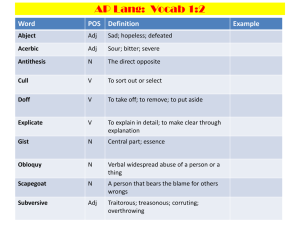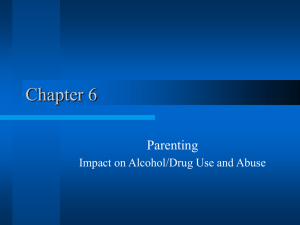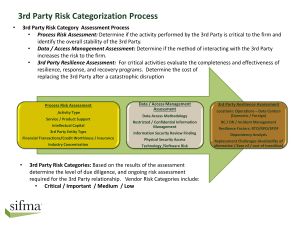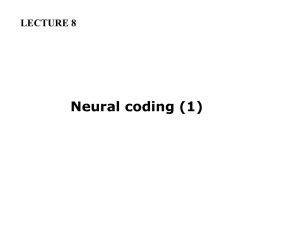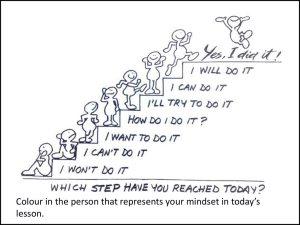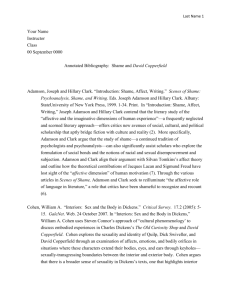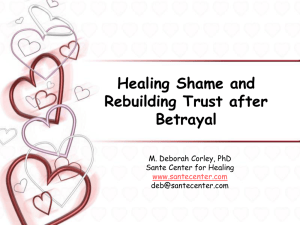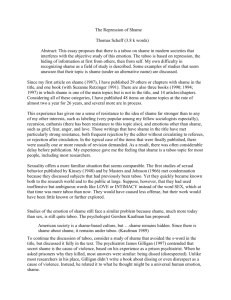presentation as PowerPoint slides
advertisement
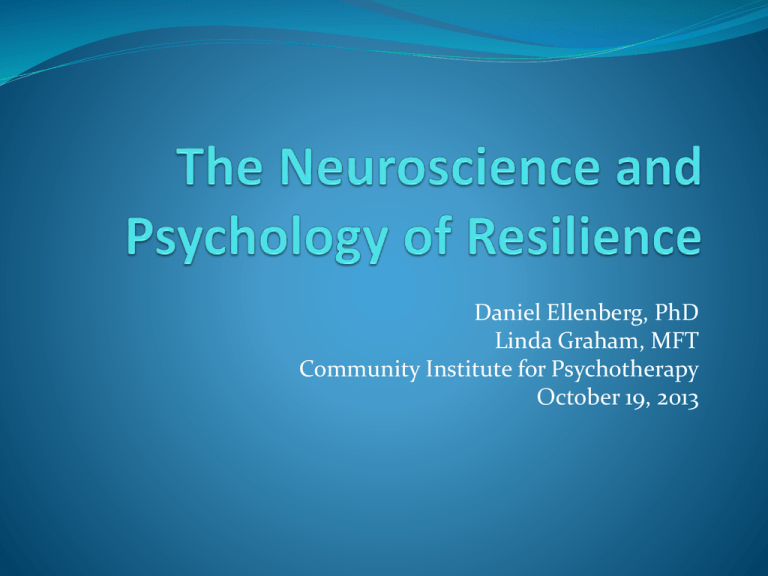
Daniel Ellenberg, PhD Linda Graham, MFT Community Institute for Psychotherapy October 19, 2013 All the world is full of suffering; It is also full of overcoming. - Helen Keller Resilience Capacities innate in the brain Hard-wired in by evolution Learned in responses to experiences and interactions encoded in neural circuitry Kindles maturation of brain, especially prefrontal cortex – CEO of resilience It is not the strongest of the species that survives, nor the most intelligent that survives. It is the one that is the most adaptive to change. - Charles Darwin The field of neuroscience is so new, We must be comfortable not only Venturing into the unknown, But into error. - Richard Mendius, M.D. Conditioning Experience causes neurons to fire Repeated experiences, repeated neural firings Neurons that fire together wire together Strengthen synaptic connections Connections stabilize into neural pathways Conditioning is neutral, wires positive and negative Neuroplasticity Growing new neurons Strengthening synaptic connections Myelinating pathways – faster processing Rebuilding brain structure Re-organizing functions of structures ….lifelong Evolutionary legacy Genetic loading Family of origin conditioning Norms-expectations of culture-society Who we are and how we cope… …is not out fault Given neuroplasticity and choices of self-directed neuroplasticity Who we are and how we cope… …is our responsibility Self-directed neuroplasticity Choosing new experiences to rewire for Resilience and well-being The brain is shaped by experience. And because we have a choice about what experiences we want to use to shape our brain, we have a responsibility to choose the experiences that will shape the brain toward the wise and the wholesome. - Richard J. Davidson, PhD Center for Investigating Healthy Minds University of Wisconsin - Madison Pre-Frontal Cortex Executive center of higher brain Evolved most recently – makes us human Development kindled in relationships Matures the latest – 25 years of age CEO of resilience Functions of Pre-Frontal Cortex Regulate body and nervous system Quell fear response of the amygdala Manage emotions Attunement – tuning into feelings Empathy – making sense of experience Insight and self-knowing Response flexibility Effective Agents of Brain Change Mindfulness (Attention Circuit) Empathy ( Resonance Circuit) Strengthen Pre-Frontal Cortex CEO of Resilience Mindfulness Focused attention on present moment experience without judgment or resistance Mindfulness Pause, become present Notice and name Step back, dis-entangle, reflect Shift perspectives Discern options Choose wisely Mindfulness and Psychotherapy Even-hovering attention Unconditional positive regard Observing ego “What are you noticing now?” Strengthens structure to see clearly Insula, anterior cingulate cortex, corpus callosum, pre-frontal cortex Resonance Circuit Resonance – brain stem Attunement – limbic system, insula, right hemisphere, mirror neurons Empathy – frontal lobes Compassion – left hemisphere, motor cortex Self-Acceptance – whole brain The roots of resilience are to be found in the felt sense of existing in the heart and mind of an empathic, attuned, self-possessed other. - Diana Fosha, PhD Mechanisms of Brain Change New conditioning Reconditioning Deconditioning New Conditioning Choose new experiences Create new learning, new memory Encode new wiring Install new patterns of response Reconditioning “Light up” neural networks Juxtapose old negative with new positive De-consolidation – Re-consolidation New rewires old Deconditioning De-focusing Loosens grip Create mental play space Plane of open possibilities New insight, new behaviors Modes of Processing Focused Self-referential Tasks and details Constellate a representation New conditioning and Reconditioning Modes of Processing Defocused Default network Fertile neural background noise Plane of open possibilities Mental play space Deconditioning Five Practices to Accelerate Brain Change Presence Intention Perseverance Refuges Resources Six C’s of Coping Calm Compassion Clarity Connections to resources Competence Courage Serenity is not freedom from the storm but peace amidst the storm. - author unknown SNS – fight-flight-freeze Relational and resilient Calm and relaxed, engaged and alert WINDOW OF TOLERANCE Baseline physiological equilibrium Equanimity PNS – appease, numb, collapse CALM – Hand on the Heart Touch – oxytocin – safety and trust Deep breathing – parasympathetic Breathing ease into heart center Brakes on survival responses Coherent heart rate Being loved and cherished Oxytocin – direct and immediate antidote to cortisol Reconditioning through Soothing, Comforting, Caring Hand on the Heart Progressive Muscle Relaxation Friendly Body Scan Movement Compassion Respond to pain or suffering with an open heart, an interested mind, and a natural willingness to help. Open to experience, activate care-giving, prime ourselves to act. “Left shift” in brain – more neural activity in left hemisphere – approach stance toward experience. Overcome negativity bias; become more optimistic, more flexible, better resources, better able to find solutions. Resonance Circuit Resonance – vibe, emotional contagion Outside of awareness Attunement – felt sense, explicit, non-verbal Empathy – verbal, cognition, coherent narrative Compassion – caring, concern, help Acceptance – pre-requisite for resilience Self-Compassion Threat-protection system Cortisol driven Pleasure-reward system Dopamine driven Caregiving-soothing-comfort system Oxytocin system Paul Gilbert, The Compassionate Mind Self-Compassion Notice this moment of suffering: “Ouch! This hurts.” What would be comforting here? What would be helpful Open to larger perspective: I’m not the only one; I’m not alone Self-Compassion Break How am I doing? Is there any suffering here? How can I be mindful and compassionate in this moment? May I be safe from inner and outer harm. May I be free of suffering, all causes of suffering, and from causing any suffering. Kindness is more important that wisdom, and the recognition of that is the beginning of wisdom. - Theodore Rubin I have learned that people will forget what you said and people will forget what you did, but people will never forget how you made them feel. - Maya Angelou Resonance Circuit Relationships kindle maturation of pre-frontal cortex Re-parenting of therapy strengthens the PFC True Other to True Self Self-directed neuroplasticity Client strengthens their own pre-frontal cortex Love makes your soul Crawl out of its hiding place. - Zora Neale Hurston Shame Shame is the intensely painful feeling or experience of believing we are flawed and therefor unworthy of acceptance and belonging. Shame creates feelings of fear, blame, and disconnection We cannot change and grow when we are in shame, and we can’t use shame to change ourselves or others. Shame erodes the part of ourselves that believes we are capable of change. Shame Shame: I am bad, flawed, unworthy, unfixable Guilt: I did something bad, regrettable; leads to healthy remorse and amends Embarrassment: triggered by event that is normal, fleeting, eventually even amusing Humiliation: recognition that event is unfair, undeserved Shame Reslience 1. Recognize shame triggers, shame identities, shame defenses 2. Contextualize – shame is not personal; it’s universal and a psycho-social construct 3. Reach out – share the story with someone who has earned the right to hear it 4. Speak the shame – ask for what is needed rather than acting out or shutting down Reconditioning Anchor in present moment awareness Resource with acceptance and goodness Start with small negative memory “Light up the networks” Evoke positive memory that contradicts or disconfirms Juxtapose - simultaneous dual awareness (or toggle) Refresh and strengthen positive Let go of negative Rest in, savor positive Reflect on shifts in perspective Wished For Outcome Evoke memory of what did happen Imagine new behaviors, new players, new resolution. Savor and strengthen Inner resources for reconditioning: Wiser Self Compassionate figure Inner resources Resources for Clients Radical Acceptance by Tara Brach Self-Compassion by Kristin Neff The Gifts of Imperfection by Brene Brown Connections to Resources People Love guards the heart from the abyss. - Mozart Place …I rest in the grace of the world….-Wendell Berry Practices As an irrigator guides water to his field, as an archer aims an arrow, as a carpenter carves wood, the wise shape their lives. - Buddha People as Resources Presence – dyadic regulation Circle of support Imagination powerful, portable Includes Wiser Self Deep listening Appreciation Positivity Portfolio Positivity Portfolio Ask 10 friends to send cards Positive appreciations Assemble phrases on piece of paper Tape to bathroom mirror or computer monitor Carry in wallet or purse Read phrases 3 times a day for 30 days Savor and appreciate Friendship and goodness Places as Resources Safe place, refuge Nature – reset contraction Nature - expansiveness Practices as Resources Paradigms – yoga, meditation, chi gong, prayer Movement – exercise Nutrition Sleep Laughter Learning Hang out with healthy brains Positive Emotions Help us feel and function better Put the brakes on negativity Antidote survival responses Foster the left shift – open to experience Broaden possibilities in the moment Build resources long-term Build resilience Positive Emotions Create: Better health and longevity Deeper social bonds Better coping with stress and trauma Creativity and productivity Confidence and cooperation Flexibility and resilience Cultivate Gratitude 2-minute free-write Gratitude journal Gratitude buddy Carry love and appreciation in your wallet Taking in the Good Notice: in the moment or in memory Drop into felt sense in the body Savor 10-20-30 seconds Anchor in cue Clarity - Mindfulness Pause, Become Present Notice and Name Step Back, Dis-Entangle, Reflect Shift Perspectives Discern Options Choose Wisely Notice and Name Thoughts as thoughts; feelings as feelings Patterns of thoughts as patterns of thoughts States of mind as states of mind Identify belief systems and identities as: Mental contents; patterns of neural firing Strengthens pre-frontal cortex, anterior cingulate, and insula Shift Perspectives Switch the channel Monitor and modify Shift from victim “me” to empowered “I” Shift the entire neural network Courage Yes, risk-taking is inherently failure-prone. Otherwise, it would be called sure-thing taking. Tim McMahon Do One Scary Thing a Day Venture into new or unknown Somatic marker of “Uh, oh.” Dopamine disrupted Cross threshold into new Satisfaction,mastery Dopamine restored I am no longer afraid of storms, for I am learning how to sail my ship. - Louisa May Alcott Daniel Ellenberg, PhD www.rewireleadership.com daniel@relationshipsthatwork.com Linda Graham, MFT www.lindagraham-mft.net lindagraham2@earthlink.net


